Pacific Ocean become a place for many water animals. Even though it is became a heaven for many water animals, many of them are endangered because of one and another reason. If in the previous posts you have known about the endangered sea lions, endangered fish species, endangered species of whales, endangered seahorses, and endangered sea turtles. I hope you still care about the ways to protect the marine life and the ways to save the ocean. So, in this article I would like to inform you the 15 endangered species in the Pacific Ocean.
1. Chaetodon lunulatus (Oval Butterflyfish)
 Oval Butterflyfish or Chaetodon lunulatus is one of the 15 endangered species in the Pacific Ocean. This fish lives along the Eastern Indonesia to the Hawaiian islands. They live about 1 m to 25 m beneath the sea around the rich coral areas of lagoons and seaward reefs because they feed on coral polyps. This fish lives on a group but you will find them more often in pairs.
Oval Butterflyfish or Chaetodon lunulatus is one of the 15 endangered species in the Pacific Ocean. This fish lives along the Eastern Indonesia to the Hawaiian islands. They live about 1 m to 25 m beneath the sea around the rich coral areas of lagoons and seaward reefs because they feed on coral polyps. This fish lives on a group but you will find them more often in pairs.
They hide their juveniles inside the corals and their length could reach up to 15 cm for adults. In the wildlife this fish could life up to 12 years. The population of this fish is decreasing because many people collect them for aquarium trade.
Besides that, coral bleaching and coral loss through out the Pacific Ocean also become a reason why this species of fish number is decreasing.
2. Sepia Apama (Australian Giant Cuttlefish)
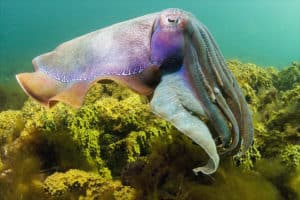
Let me introduce you to the largest cuttlefish in the world, Australian Giant Cuttlefish. This is because this cuttlefish could reach the mantle length up to 50 cm and over 10.5 kg in weight. Just like its name, you can find this cuttlefish along the southern coast of Australia in the rocky reefs, seagrass beds, and sand and mud seafloor up to 100 m depth.
This fish feeds on shrimp, fish and small crabs, they use their ability to change its color before they catch their prey. This fish only lives up to three years. Once the fish breed, it could spawn about 200 eggs.
Then, it attaches their eggs inside the rock in the caves for three to five months before the eggs hatch. This fish is a food for the bottlenose dolphin. The decreasing number of this fish is caused by the high fishing activity and the increasing level of carbon dioxide.
3. Carcharhinus leucas (Bull Shark)
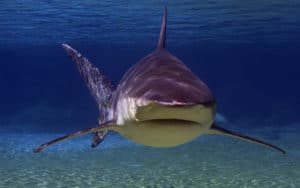 This species of shark can lives both in the saltwater and freshwater and known as a dangerous species of shark to human. This shark is commonly found in the coastal areas of warm oceans, including Pacific Ocean.
This species of shark can lives both in the saltwater and freshwater and known as a dangerous species of shark to human. This shark is commonly found in the coastal areas of warm oceans, including Pacific Ocean.
They could swim up to 150 m depth, but they usually swim in the 30 m depth. This shark feeds on fish and became the prey of tiger shark. Bull shark’s life span is about 16 to 25 years in the wildlife. About their size, they could reach up to 3.5 m length and weight up to 230 kg with females bigger than males. Bull shark can breed up to 10 sharks.
Bull shark became the species that should be protected because many of them are hunted by humans for its skin, liver oil, flesh, and its fins.
4. Acropora florida (Branch Coral)
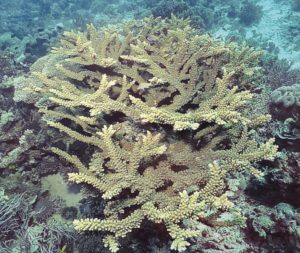 If you want to find this beautiful coral, you can look for it along the west side of Pacific Ocean. But you can also find them in the six region of Indonesia with 5 m to 30 m depth in the reef tops, walls and slopes. They feed on plankton and get its nutritional needs from the dinoflagellates inside its soft tissues.
If you want to find this beautiful coral, you can look for it along the west side of Pacific Ocean. But you can also find them in the six region of Indonesia with 5 m to 30 m depth in the reef tops, walls and slopes. They feed on plankton and get its nutritional needs from the dinoflagellates inside its soft tissues.
About its life span, this coral could lives between 15 to 30 years. Its size is small, only about 1 cm to 3 cm, even if their size are small, they live in a colony and together they create a beautiful branch coral. Climate change, extreme weather events, rising sea water temperatures (global warming in ocean), acidification of the ocean, sedimentation, and fisheries are some from many factors that decrease the population of branch coral.
Related articles:
- Main Producers in Ocean Ecosystems
- Ocean Sediments
- Effects of Greenhouse
- Conservation of Coral Reef
- Ocean Coral Reef
5. Balaenoptera musculus (Blue Whale)
 Previously I have introduced you to the largest cuttlefish in the world, and now I would like to introduce you to the largest animal ever known, blue whale. Its length could reach up to 29.9 m with its weight up to 173 tonnes. Before a century of hunted, blue whale could be found in almost all around the world. However, today you nearly could find them in the eastern north pacific.
Previously I have introduced you to the largest cuttlefish in the world, and now I would like to introduce you to the largest animal ever known, blue whale. Its length could reach up to 29.9 m with its weight up to 173 tonnes. Before a century of hunted, blue whale could be found in almost all around the world. However, today you nearly could find them in the eastern north pacific.
Even though their size are huge, blue whale feed on small crustacean such as krill and copepod. To find krill and copepod, blue whales usually dive at depth more than 100 m. Blue whales also could live up tp 45 years in the wildlife. The biggest tread of blue whale population in the past was whaling, but since many organization try to protect this mammal, climate change became the other tread to this whale.
Related article:
6. Cetorhinus maximus (Basking Shark)
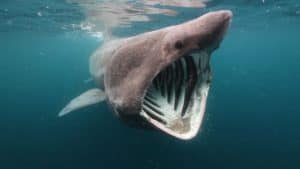 Top 2, as the second world’s biggest fish is basking shark. It could reach 8 m in length, but some people found it could reach up to 12 m length with weight up to 21 tonnes. You can find this shark along the Pacific Ocean from the surface up to 910 m depth. They live in a group but you will often find them singly. They feed on fish, plankton, and another invertebrates.
Top 2, as the second world’s biggest fish is basking shark. It could reach 8 m in length, but some people found it could reach up to 12 m length with weight up to 21 tonnes. You can find this shark along the Pacific Ocean from the surface up to 910 m depth. They live in a group but you will often find them singly. They feed on fish, plankton, and another invertebrates.
Basking shark became a prey for tiger shark and killer whales. Their life span is between 20 to 100 years. Because of its slow swimming speed, basking shark is haunted for its flesh, fins, and shark liver oil.
7. Eretmochelys imbricate (Hawksbill Turtle)
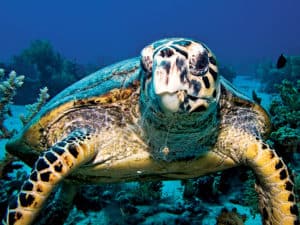 Another endangered species in the Pacific Ocean is hawksbill turtle. Hawksbill turtle lives in the coral reef along the Pacific Ocean. They mainly feed on sponge in coral, crustaceans, algae, and fish. Their length could reach up to 1 m with 80 kg of weight. Once they breed, they could spawn up to 140 eggs.
Another endangered species in the Pacific Ocean is hawksbill turtle. Hawksbill turtle lives in the coral reef along the Pacific Ocean. They mainly feed on sponge in coral, crustaceans, algae, and fish. Their length could reach up to 1 m with 80 kg of weight. Once they breed, they could spawn up to 140 eggs.
Their life span is unknown but most turtles could life up to 80 years. Hawksbill turtle is classified as a low fecundity animal, they reach their maturity on the age of 20. Because this turtle mainly loves to stay close the shoreline because this is where sponge bearing coral reefs can be found, this makes hawksbill turtle easily hunt by humans. This animal is being hunted as delicacy, decoration, and souvenir from its shell scutes.
Related article: Endangered Sea Turtles List
8. Phoeocna sinus (Vaquita)
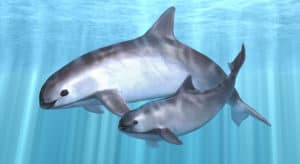 Vaquita or known as a little cow in Spanish could be found along the eastern central Pacific Ocean. Their length could reach up to 135 cm for males and 141 for females. They usually live in a small group with two or three individuals.
Vaquita or known as a little cow in Spanish could be found along the eastern central Pacific Ocean. Their length could reach up to 135 cm for males and 141 for females. They usually live in a small group with two or three individuals.
This animals known can swim deeper than 30 m. And they could live up to 20 years in the wildlife. Their population is decreasing because of the market demand as delicacy and trading.
Read also:
9. Dugong Dugon (Dugong)
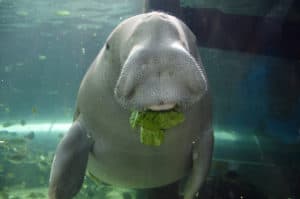 Dugong or mainly known as a sea cow is a marine mammal. The population of dugong is widely spread trough out 40 countries in Indo – Pacific territories. They will be mainly found in warm waters around the coast, around their food, which is sea grass. Most of them are herbivores but few of them feed on jellyfish, sea squirt, and shellfish.
Dugong or mainly known as a sea cow is a marine mammal. The population of dugong is widely spread trough out 40 countries in Indo – Pacific territories. They will be mainly found in warm waters around the coast, around their food, which is sea grass. Most of them are herbivores but few of them feed on jellyfish, sea squirt, and shellfish.
Its length could reach up to 3 m with 400 kg of weight. Dugong’s life span could reach up to 70 years in the wildlife. Their population is being threatened by human activity who hunts for their skin, meat, oil, and bones.
Some of their body’s part are used to make as food, medicine, and decoration. Its ribswere used as carvings in Japan.
10. Anoxypristis cuspidata (Narrow Sawfish)
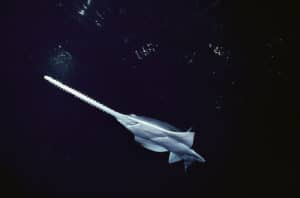
Narrow sawfish or also known as knifetooth sawfish is a fish who lives in the depth of 40 m in western central and northwest Pacific. This fish could reach its length up to 4.7 m. This fish feeds on small fish, squid, shrimps, and crabs.
Its name exist in the 15 endangered species in Pacific Ocean because they are hunted by humans, the increasing of coastal development such as mining also decreasing the number if this fish. Basically, not only this species of sawfish is endangered,but all species of sawfish are endangered.
11. Cheilinus undulatus (Humpheas Wrasse)
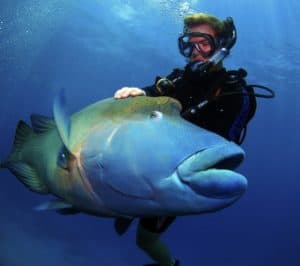 This fish will be mainly found in coral reef through out the Indo – Pacific region with 1 m to 100 m depth. This fish could reach its length up to 2 m with 180 kg of weight. However, you will usually find them, with length less than 1 m. This fish life span is between 45 to 50 years, with females live longer than males.
This fish will be mainly found in coral reef through out the Indo – Pacific region with 1 m to 100 m depth. This fish could reach its length up to 2 m with 180 kg of weight. However, you will usually find them, with length less than 1 m. This fish life span is between 45 to 50 years, with females live longer than males.
Even though their life span is long but their fecundity are low because they reach their sexual maturity at the age of six. This fish feeds on invertebrates such as mollusk and vertebrates such as fish. The main tread for the population of humpheas wrasse are illegal fishing for its juveniles for direct export, and ocean acidification.
See also: Endangered Dolphin Species
12. Rhincodon typus (Whale Shark)
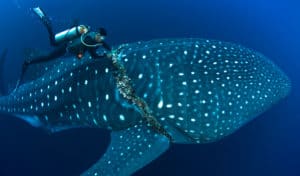 Top 1, as the largest fish in the world is whale shark. This species of shark could reach its length up to 12.65 m with 21.5 tonnes of weight. They could be found in warm temperate sea such as the Pacific Ocean with 1928 m depth. Just like basking shark and blue whales, this giant fish feed on small animals such as krill, copepod, plankton, squid, and small fish.
Top 1, as the largest fish in the world is whale shark. This species of shark could reach its length up to 12.65 m with 21.5 tonnes of weight. They could be found in warm temperate sea such as the Pacific Ocean with 1928 m depth. Just like basking shark and blue whales, this giant fish feed on small animals such as krill, copepod, plankton, squid, and small fish.
Even though classified as shark, this whale shark is not dangerous for humans. Their life span in the wildlife could reach up to 70 years. During the whale shark pregnancy, there are about 100 eggs incubated by the females whale shark, but there is only few egg cold turn into baby whale shark. This species is considered as endangered because of the high fishing of this species for commercial purposes.
13. Aetomylaeus maculatus (Mottled Eagle Ray)

Northwest and western central Pacific are the place where this ray lives in the depth of 60 m. There is only a few things known from this endangered ray, this ray could reach its disc width up to 78 cm with the annual litter size of 4.
Meanwhile, their size in maturity is 55 cm disc width for females and 71 cm in disc width for males. The decreasing number of this fish is because of intense fisheries to fulfill the market demand on Thailand and Malaysia.
See also: Endangered Sea Cucumbers
14. Neomonachus schauinslandi (Hawaiian Monk Seal)
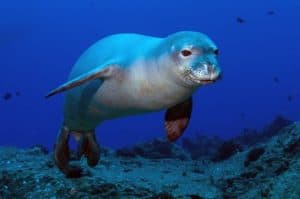 This seal is an endemic of Hawaiian Islands through out the eastern central and northwest Pacific. They could swim more than 300 m beneath the sea and usually be found around the lagoons. The adult seal could reach its length up to 2.1 m with 240 kg of weight. This seal feeds on bony fish, cephalopods, small octopus, and crustacean.
This seal is an endemic of Hawaiian Islands through out the eastern central and northwest Pacific. They could swim more than 300 m beneath the sea and usually be found around the lagoons. The adult seal could reach its length up to 2.1 m with 240 kg of weight. This seal feeds on bony fish, cephalopods, small octopus, and crustacean.
Hawaiian monk seal is a prey for tiger shark, and galapagos shark. There are some factors that affect the declining number of hawaiian monk seal such as their low fecundity, their high mortality, predation from shark, and hunting by human.
15. Haliotis cracherodii (Black Abalone)
 This native species from eastern central Pacific is could be found in the 6 m depth. They could live up to 30 years and start reproduce between the age of three to seven years. The length of this abalone could reach up to 20 cm and they feed on drift algae and kelp.
This native species from eastern central Pacific is could be found in the 6 m depth. They could live up to 30 years and start reproduce between the age of three to seven years. The length of this abalone could reach up to 20 cm and they feed on drift algae and kelp.
Besides mankind, the predator of this animal is sea otters. The population of this black abalone is declining because of the hunting by human, predation and the Withering Syndrome.
Read also: Ocean Seashells and Types of Algae
Mostly, the factors that may cause those species became the 15 endangered species in Pacific Ocean is because the hunting by human, predation, and climate change. Thank you for keep reading this article until the end and hopefully this article could help you to know and protect animals.